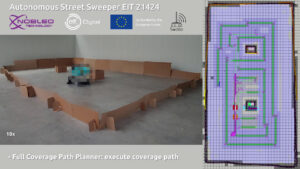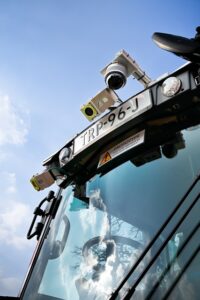Autonomous Street Sweeper EIT project
Cleaning streets is essential for well-being in cities. Similarly, cleaning industrial floors is important for productivity in industrial buildings. These tasks are performed using industrial sweepers, which require precise maneuvering, especially when they need to clean close to objects and in a dynamic environment with moving objects and people. Operation of such machine is low-income labour, for which it is increasingly difficult to find well-trained people.
However, it also means that there is a great potential to automate such tasks. On top of helping the labour shortage, it allows the task execution at quite hours, for instance during the night, to reduce disturbing the working flow during busy hours. Nobleo had an initiative to explore the market of outdoor and indoor sweeping via an EIT project, where we successfully open up opportunities.
Indoor cleaning
We have fully converted to steered-by-wire an existing industrial indoor sweeper, which was previously manually operated, such that all tools and the machine itself can be steered from a computer. Next, we have developed planning and navigation algorithms to autonomously clean an indoor hall, including the areas close to walls.

Outdoor cleaning
Outdoor sweeping vehicles are complex machines, and their operation require a lot of multi-tasking which includes: handling side brushes horizontal and vertical position and their speed, suction nozzle height and power, steering the vehicle, etc. We have taken an incremental approach for autonomy, and we have started by automating the side brushes positioning. The detection of the cleaning edge is the most challenging part of this task, which we tackle using AI and 3D vision technology.
There are many challenges ahead, especially when operating in highly dynamic environments. It is within our vision, and that of our clients, that these vehicles will also be fully automated in the near future. Nobleo is convinced that technology can contribute to the well-being of our cities.

This activity has received funding from the European Institute of Innovation and Technology (EIT). This body of the European Union receives support from the European Union’s Horizon Europe research and innovation programme.
